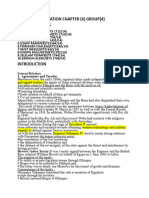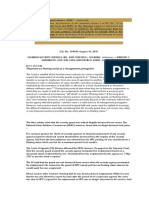History Assignment
History Assignment
Uploaded by
tesfayeseid7Copyright:
Available Formats
History Assignment
History Assignment
Uploaded by
tesfayeseid7Original Title
Copyright
Available Formats
Share this document
Did you find this document useful?
Is this content inappropriate?
Copyright:
Available Formats
History Assignment
History Assignment
Uploaded by
tesfayeseid7Copyright:
Available Formats
6.2.
The Making of Modern Ethiopian State
The making of the modern Ethiopian state went through two distinct phases.
A. unifying different regions and peoples in north and north central parts of Ethiopia.
B. territorial expansion into the southern parts of the country.
A. The Process of Territorial Unification
The territorial unification ushered in a revival of the imperial power, which had declined during the
Zemene-Mesafint. The main figure was Kasa Hailu of Quara who later became Emperor Tewodros II
of Ethiopia. After he became emperor In 1837 he assisted his brother Dejjazmach Kinfu in defeating
the Egyptians at Wad Kaltabu (in present-day eastern Sudan). In 1848, Kasa fought against the
Egyptians at Dabarki (again in present Sudan). Kasa’s forces lost the battle owing to the Egyptians’
superior military organization, discipline, and better arms. kasa became a concern to the werra
sheh(yeju) ruling house and they arranged marriage between kasa and mentwab (daughter of ali II) and
he became governor of Quara. Due to mistreatment from mentwab’s relative he resumed shiftnet after
this more wares breakout.
November 27, 1852 Kasa defeated Dejjach Goshu Zewde of Gojjam at Gur Amba
April 12, 1853 Birru Aligaz, Aben, Yazew and Belew, the four dejjazmachs at Taqusa (Gorgora
Bichign)
Ras Ali at Ayshal on 29 June 1853 and Dejjazmach Wube of Simen and Tigray at Deresge on
8 February, 1855. And at February 9 1855 he became Tewodros II king of kings of ethiopia.
Some internal and external factors lead to tewodross downfall these are internal and external cases
Internally broke out of rebellions and externally serious diplomatic crisis following the imprisonment
of a handful of Britons and other Europeans. Which leads Tewodros committing suicide on April 13,
1868 in the battle at mekdelamba. The death of Tewodros leads to the emerge of contenders
Wagshum Gobeze of Lasta, Kasa Mircha of Tigray and Menilek of Shewa. wagshum gobeze
Took the seat but emperor kasa mircha (yohannes Iv) became the emperor at the battle of assam July
1871. He attempte to built decentralized system of administration and He succeeded in achieving the
unity of the predominantly-Christian provinces. He lead EOC to religious unity in the country as a
whole. Emperor Yohannes faced rebellins due to religion and external challenges from Egyptians,
Italians, and the Mahdists at different times. And he died at by mehdists at Metemma in 1889. As a
result, the throne was assumed by Negus Menilek of Shewa who became Emperor Menilek II (1889-
1913).
C. Territorial Expansion
Emperor Tewodros II, Emperor Yohannes IV and others made state building their mission and
struggled to achieve that goal. Yet, the most successful was Menilek of Shewa. This was because
Menilek had, access to modern firearms. The control of resource rich areas to build military force and
determination of his generals. Phases of territorial expansion of menilik
1. 1875-1889 he aimed for the crown.
2. 1889-1996 expansion for the aim of preparation for a war against Italy
3. 1896-1900 The process of territorial expansion was consummated with the signing of
boundary agreements with the neighboring colonial powers that continued until 1908.
Most of these treaties were signed after the victory of Adwa.
6.3. Modernization Attempts
kasa’s defeat by the well-trained and equipped Egyptian troops made him think putting the country
“on an equal footing with European powers.” Which lead him to take military, administrative and
socio-economic reform measures.
Emperor Yohannes' reign also first Ethiopian monarch to appoint foreign consul, he sent some
individuals abroad for modern education and introduce modern style vaccine against smallpox.
Emperor Menilek had diverse elements which are the establishment of a postal service and
telecommunications/ the telephone-telegraph system, the construction of railway, the opening of a
bank (the Bank of Abyssinia) and the introduction of silver coin. Administration system He introduced
a policy of auditing of government accounts, and he tried to integrate Ethiopian Muslims into the
administration structure.
During the Dual Rule of Empress Zewditu and Ras Teferi (r. 1916-1930), the entry of Ethiopia into the
League of Nations centralization of the government, promulgation of Ethiopia’s first constitution in
1931, establishment of Imperial Body Guard in 1930, opening of Ethiopia’s first Military Academy at
Holeta with the help of a Swedish military mission in 1934.
You might also like
- Blumler - The Fourth Age of Political Communication (2013)Document6 pagesBlumler - The Fourth Age of Political Communication (2013)Fernando GarcíaNo ratings yet
- A Big Lyrical DigressionDocument240 pagesA Big Lyrical DigressionZebdequit100% (1)
- Analysis of The Poem Caged BirdDocument13 pagesAnalysis of The Poem Caged BirdIrna Sofia67% (3)
- The Making of Modern Ethiopian State Assignment AdmasDocument8 pagesThe Making of Modern Ethiopian State Assignment AdmasEyob Astatke100% (4)
- Unit 6Document39 pagesUnit 6Rebuma BekeleNo ratings yet
- History AssignmentDocument14 pagesHistory AssignmentMesud GemechuNo ratings yet
- Chapter 6 HistoryDocument31 pagesChapter 6 HistoryKirubel Mulugeta100% (5)
- Ethiopian History (Territoriak and Economic)Document6 pagesEthiopian History (Territoriak and Economic)eyob astatkeNo ratings yet
- Unit 6 History of EHDocument31 pagesUnit 6 History of EHyddiyashiferawNo ratings yet
- The Making of The Modern Ethiopian Empire 1855Document8 pagesThe Making of The Modern Ethiopian Empire 1855Selam Tenaye100% (2)
- The Formation of Modern Ethiopian State and Its Contradictory InterpretationsDocument14 pagesThe Formation of Modern Ethiopian State and Its Contradictory InterpretationsENIYEW EYASUNo ratings yet
- UpdatedHistory@Remedial Ppt#unit 6Document36 pagesUpdatedHistory@Remedial Ppt#unit 6Usman KassawNo ratings yet
- Emergence of Modern EthiopiaDocument17 pagesEmergence of Modern EthiopiaZelalemNo ratings yet
- History of Ethiopia & The Horn Unit 6Document34 pagesHistory of Ethiopia & The Horn Unit 6metsihetfkade68No ratings yet
- The Gonderian Period and Zemene MesafintDocument11 pagesThe Gonderian Period and Zemene Mesafintautisticuserr100% (4)
- Victory at Adowa!: Rastafari Online SpecialDocument8 pagesVictory at Adowa!: Rastafari Online Specialephrem tamiruNo ratings yet
- Internal Developments and External Relations of Ethiopia and The Horn, 1800-1941Document73 pagesInternal Developments and External Relations of Ethiopia and The Horn, 1800-1941Yoftahe Alemu100% (1)
- Global Trends AssignmentDocument11 pagesGlobal Trends Assignmentkidistzewdu956No ratings yet
- Hist 6Document36 pagesHist 6mitiku4m100% (1)
- History Presentation Chapter SixDocument5 pagesHistory Presentation Chapter SixTemesgenNo ratings yet
- Ethiopia Notes 2Document7 pagesEthiopia Notes 2MrPizza FarmerDudeNo ratings yet
- A Dwa BattleDocument14 pagesA Dwa BattleJohnNo ratings yet
- Unit 6 The Formation of The Modern State of Ethiopia From 1855 ToDocument65 pagesUnit 6 The Formation of The Modern State of Ethiopia From 1855 Toctfs7zt622No ratings yet
- The Nature of Interactions Among Peoples and States of Ethiopia and The HornDocument15 pagesThe Nature of Interactions Among Peoples and States of Ethiopia and The Hornmesfin teshomeNo ratings yet
- Unit-3 (BT)Document7 pagesUnit-3 (BT)Amanuel AyalewNo ratings yet
- Tewodros IIDocument6 pagesTewodros IImiki mikiNo ratings yet
- Week 2 History Lesson NotesDocument56 pagesWeek 2 History Lesson NotesKassa MekonnenNo ratings yet
- Inception of Political R ND Foreign ThreatDocument4 pagesInception of Political R ND Foreign ThreatGetawNo ratings yet
- ʜɪsᴛᴏʀʏ ᴏғ ᴇᴛʜɪᴏᴘɪᴀ ᴀɴᴅ ᴛʜᴇ ʜᴏʀɴDocument5 pagesʜɪsᴛᴏʀʏ ᴏғ ᴇᴛʜɪᴏᴘɪᴀ ᴀɴᴅ ᴛʜᴇ ʜᴏʀɴHermela WorkuNo ratings yet
- UntitledDocument13 pagesUntitledKasech WoldaNo ratings yet
- MimisobajugurupDocument5 pagesMimisobajugurupSAMI ZNo ratings yet
- Chapter SixDocument28 pagesChapter SixDemeke DanaNo ratings yet
- Chapter SixDocument46 pagesChapter Sixfarxaanyuusuf996No ratings yet
- Zemene MesafintDocument15 pagesZemene Mesafintjuliarthur2280% (5)
- History AssignmentDocument11 pagesHistory Assignmentnatty.sol2093No ratings yet
- Expansion To Southwest, South and Southeast PDFDocument3 pagesExpansion To Southwest, South and Southeast PDFrekikNo ratings yet
- Zemene Mesafent 1Document12 pagesZemene Mesafent 1hosanagirmay0No ratings yet
- A Glimpse of History of Power, Treachery, Diplomacy and War in Ethiopia 1889-1906Document18 pagesA Glimpse of History of Power, Treachery, Diplomacy and War in Ethiopia 1889-1906TWWNo ratings yet
- A Glimpse of History of Power, Treachery, Diplomacy and War in Ethiopia 1889-1906Document18 pagesA Glimpse of History of Power, Treachery, Diplomacy and War in Ethiopia 1889-1906TWWNo ratings yet
- HITORY WORK SHEET Gade 9Document18 pagesHITORY WORK SHEET Gade 9Dawit BerheNo ratings yet
- Hist. PP 6-1Document41 pagesHist. PP 6-1Tesfu HettoNo ratings yet
- ETFPDDocument73 pagesETFPDBruk AmareNo ratings yet
- History of Ethiopia & The Horn Unit 6Document41 pagesHistory of Ethiopia & The Horn Unit 6benjamin abewa0% (1)
- History Short Note For Grade 10Document5 pagesHistory Short Note For Grade 10the amazing sarem the amazing sarem75% (8)
- Greece 20th CenturyDocument2 pagesGreece 20th CenturykaterinasikinouNo ratings yet
- Compare The Contribution of Theodor and Johannes IV To The Unity and Modernization of EthiopiaDocument4 pagesCompare The Contribution of Theodor and Johannes IV To The Unity and Modernization of EthiopiaTapiwa SatoNo ratings yet
- Zemene Mesafint - Era of PrincesDocument10 pagesZemene Mesafint - Era of PrincesAbenezer KassahunNo ratings yet
- Group 4 History AssignmentDocument30 pagesGroup 4 History AssignmentalazarmatiyosNo ratings yet
- Emperor of Ethiopia - WikipediaDocument41 pagesEmperor of Ethiopia - WikipediaEndhy Wisnu NovindraNo ratings yet
- Menelik II - WikipediaDocument35 pagesMenelik II - WikipediaRemadan AdusNo ratings yet
- Ethiopia 1Document1 pageEthiopia 1Yitbarek getuNo ratings yet
- History of Ethiopia & The Horn Unit 6Document41 pagesHistory of Ethiopia & The Horn Unit 6tesfalemmathewos20No ratings yet
- Imeinecke,+Journal+Manager,+Aeth+13+ +04+ +Coleman,+Sterling+Joseph+ +HUP PLUSDocument30 pagesImeinecke,+Journal+Manager,+Aeth+13+ +04+ +Coleman,+Sterling+Joseph+ +HUP PLUSyosefbayuma68No ratings yet
- Negus Negast: Ethiopian Triumph in The FirstDocument25 pagesNegus Negast: Ethiopian Triumph in The FirstLazarus Kadett NdivayeleNo ratings yet
- Michigan State University Press Northeast African StudiesDocument25 pagesMichigan State University Press Northeast African StudiesAbenezer SamuelNo ratings yet
- Atse Menelik Ena YeEthiopia AndenetDocument8 pagesAtse Menelik Ena YeEthiopia Andenetkidusyonas96No ratings yet
- History Grade 12Document2 pagesHistory Grade 12Tokuma Aman100% (1)
- Chapter FourDocument40 pagesChapter Fourdagne mom100% (1)
- The Gondrian PeriodDocument6 pagesThe Gondrian PeriodwabdushukurNo ratings yet
- Chapter 4HIST CCDocument48 pagesChapter 4HIST CCnafyjabesa1No ratings yet
- Gondar PeriodDocument2 pagesGondar Periodyonassheleme1122No ratings yet
- Un 6 CommonDocument25 pagesUn 6 CommonYoni GechNo ratings yet
- Floor 4Document1 pageFloor 4tesfayeseid7No ratings yet
- Floor 3Document1 pageFloor 3tesfayeseid7No ratings yet
- Group 5 AssoignmentDocument4 pagesGroup 5 Assoignmenttesfayeseid7No ratings yet
- SCALE 1:50 SCALE 1:50: Ground Floor First FloorDocument1 pageSCALE 1:50 SCALE 1:50: Ground Floor First Floortesfayeseid7No ratings yet
- SCALE 1:50 SCALE 1:50 1 1 2 3 3 2: Rear Side Elevation Front Side ElevationDocument1 pageSCALE 1:50 SCALE 1:50 1 1 2 3 3 2: Rear Side Elevation Front Side Elevationtesfayeseid7No ratings yet
- Good Offices and Shuttle DiplomacyDocument4 pagesGood Offices and Shuttle DiplomacyAlexia AlexiutzaNo ratings yet
- Jadwal Penilaian Akhir Semester Genap SMK Ti Dadaha Informatik TAHUN AJARAN 2021/2022 Jadwal TeoriDocument7 pagesJadwal Penilaian Akhir Semester Genap SMK Ti Dadaha Informatik TAHUN AJARAN 2021/2022 Jadwal Teoriandi batikNo ratings yet
- Sharad Patil's Pathfinding Soutrantik MarxismDocument4 pagesSharad Patil's Pathfinding Soutrantik Marxismrajkumar ghogareNo ratings yet
- Fundamentos de Antropología Yepes y Aranguren LA CULTURADocument16 pagesFundamentos de Antropología Yepes y Aranguren LA CULTURALucas Lucas100% (1)
- Degradasi Keadilan Agraria Dalam Omnibus-Law: (Diterima 13 Januari 2021, Disetujui 01 Februari 2021)Document21 pagesDegradasi Keadilan Agraria Dalam Omnibus-Law: (Diterima 13 Januari 2021, Disetujui 01 Februari 2021)gabriella hutasoitNo ratings yet
- Thayer Consultancy Monthly Report 4 April 2024Document20 pagesThayer Consultancy Monthly Report 4 April 2024Carlyle Alan ThayerNo ratings yet
- Government of India Ministry of Railways Railway Recruitment BoardsDocument3 pagesGovernment of India Ministry of Railways Railway Recruitment BoardsRahman AliNo ratings yet
- St. Martin Funeral Home v. NLRCDocument3 pagesSt. Martin Funeral Home v. NLRCJeoffrey Agnes Sedanza PusayNo ratings yet
- Imran Hosein + MorrisDocument15 pagesImran Hosein + Morrismorris108No ratings yet
- Legally Blonde - Gendered AnalysisDocument4 pagesLegally Blonde - Gendered AnalysisHazel Marie PerezNo ratings yet
- SyllabusDocument3 pagesSyllabusGi YoonNo ratings yet
- "WWII" Redirects Here. For Other Uses, See .: World War IIDocument5 pages"WWII" Redirects Here. For Other Uses, See .: World War IIMj Payal0% (1)
- Asian Regionalism: A Style of Its OwnDocument21 pagesAsian Regionalism: A Style of Its OwnNaitsirhc NaitsirhcNo ratings yet
- Presentation On Benazir's Second TenureDocument16 pagesPresentation On Benazir's Second TenureFatimaNo ratings yet
- Exhibit 12-BDocument4 pagesExhibit 12-BL. A. PatersonNo ratings yet
- Villavicencio V LukbanDocument2 pagesVillavicencio V Lukbandyajee1986No ratings yet
- Bora Touch Esq Cambodia Legal Systems of The World 2000Document8 pagesBora Touch Esq Cambodia Legal Systems of The World 2000tepantreeNo ratings yet
- Student AssignmentDocument3 pagesStudent Assignmentapi-332803439No ratings yet
- Jonshon & Jonshon and Its Feature in BusinessDocument8 pagesJonshon & Jonshon and Its Feature in BusinessmashakkaliNo ratings yet
- RopDocument31 pagesRopAristo VitoNo ratings yet
- IPIR ViennaDocument73 pagesIPIR ViennaharisdcNo ratings yet
- Karl Marx PresentationDocument27 pagesKarl Marx PresentationJoella100% (1)
- M Karunanidhi SunsetDocument7 pagesM Karunanidhi SunsetMadhavan SridharNo ratings yet
- USAID To Haiti: Ilham Awaad Claudia ToscanoDocument16 pagesUSAID To Haiti: Ilham Awaad Claudia ToscanoClaudia ToscanoNo ratings yet
- Interpretation and Retrieval: Rereading Beauvoir: Linda SingerDocument8 pagesInterpretation and Retrieval: Rereading Beauvoir: Linda SingerPanayiota CharalambousNo ratings yet
- Final Exam Reviewer - RizalDocument2 pagesFinal Exam Reviewer - RizalMarc Daniel Fernandez75% (4)
- Robert Daniels, The Conscience of The RevolutionDocument502 pagesRobert Daniels, The Conscience of The RevolutionLucas MalaspinaNo ratings yet






























































































